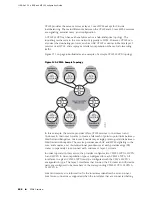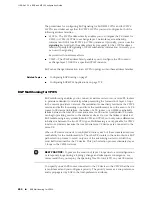
provider core, also known as an MPLS backbone. Each VPWS L2VPN consists of the
set of provider edge routers running the corresponding VPWS instance. To provide
connectivity for the L2VPN, BGP builds pseudowires between the VPWS instances
on the provider edge routers participating in a particular VPWS L2VPN point-to-point
connection.
Figure 132 on page 648 depicts two L2VPNs: L2VPN A and L2VPN B. L2VPN A connects
Customer A’s Boston and Chicago offices, and consists of provider edge routers PE
1 and PE 2, each of which runs a VPWS instance named l2vpnA. Similarly, L2VPN
B connects Customer B’s Boston and Chicago offices, and consists of provider edge
routers PE 1 and PE 2, each of which also runs a VPWS instance named l2vpnB.
Customer Edge Devices
Figure 132 on page 648 shows four customer edge devices: CE 1, CE 2, CE 3, and
CE 4. Each CE device is located at the edge of a customer site. In the sample topology,
CE 1 and CE 3 are members of L2VPN A, and CE 2 and CE 4 are members of L2VPN B.
A CE device can be a single host, a switch, or, most typically, a router. Each CE device
is directly connected to an VPWS provider edge router by means of a layer 2 interface.
VPWS Provider Edge Devices
In a VPWS configuration, E Series routers function as provider edge devices, which
are also referred to as PE routers. These PE routers perform a similar function to PE
routers in a BGP/MPLS VPN configuration.
Figure 132 on page 648 depicts two PE routers: PE 1, which is the local router, and
PE 2, which is the remote router located at the other side of the service provider
core. Each PE router must have an VPWS instance configured for each L2VPN in
which it participates. Consequently, the sample topology comprises four separate
VPWS instances: instances l2vpnA and l2vpnB configured on PE 1, and instances
l2vpnA and l2vpnB configured with matching route target values on PE 2.
Each VPWS instance configured on the router is associated with two types of
interfaces. The CE-facing or customer-facing interface is a layer 2 interface that
directly connects the PE router to a local CE device. The router encapsulates layer 2
frames from the CE device in an MPLS packet and then forwards the encapsulated
frames to the service provider core from an MPLS interface through the provider (P)
router. This encapsulation is identical to Martini encapsulation for layer 2 services
over MPLS.
VPWS and BGP/MPLS VPNs
BGP multiprotocol extensions (MP-BGP) enable BGP to support IPv4 services such as
BGP/MPLS VPNs, which are sometimes known as RFC 2547bis VPNs. A VPWS L2VPN
is actually a BGP-MPLS application that has much in common with BGP/MPLS VPNs.
VPWS and BGP/MPLS VPNs
■
649
Chapter 12: VPWS Overview
Summary of Contents for BGP
Page 6: ...vi ...
Page 8: ...viii JUNOSe 11 1 x BGP and MPLS Configuration Guide ...
Page 37: ...Part 1 Border Gateway Protocol Configuring BGP Routing on page 3 Border Gateway Protocol 1 ...
Page 38: ...2 Border Gateway Protocol JUNOSe 11 1 x BGP and MPLS Configuration Guide ...
Page 234: ...198 Monitoring BGP JUNOSe 11 1 x BGP and MPLS Configuration Guide ...
Page 236: ...200 Multiprotocol Layer Switching JUNOSe 11 1 x BGP and MPLS Configuration Guide ...
Page 542: ...506 Monitoring BGP MPLS VPNs JUNOSe 11 1 x BGP and MPLS Configuration Guide ...
Page 544: ...508 Layer 2 Services Over MPLS JUNOSe 11 1 x BGP and MPLS Configuration Guide ...
Page 610: ...574 Virtual Private LAN Service JUNOSe 11 1 x BGP and MPLS Configuration Guide ...
Page 624: ...588 VPLS References JUNOSe 11 1 x BGP and MPLS Configuration Guide ...
Page 680: ...644 Virtual Private Wire Service JUNOSe 11 1 x BGP and MPLS Configuration Guide ...
Page 724: ...688 Monitoring MPLS Forwarding Table for VPWS JUNOSe 11 1 x BGP and MPLS Configuration Guide ...
Page 725: ...Part 6 Index Index on page 691 Index 689 ...
Page 726: ...690 Index JUNOSe 11 1 x BGP and MPLS Configuration Guide ...
















































